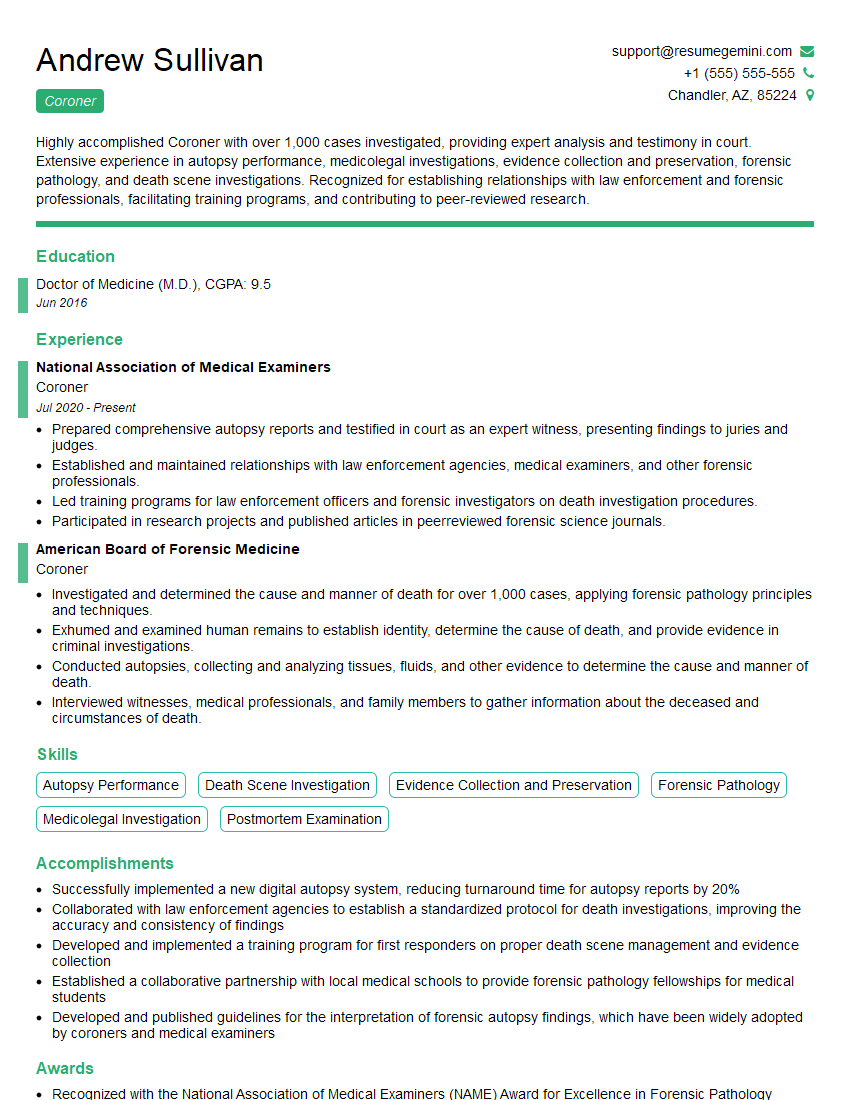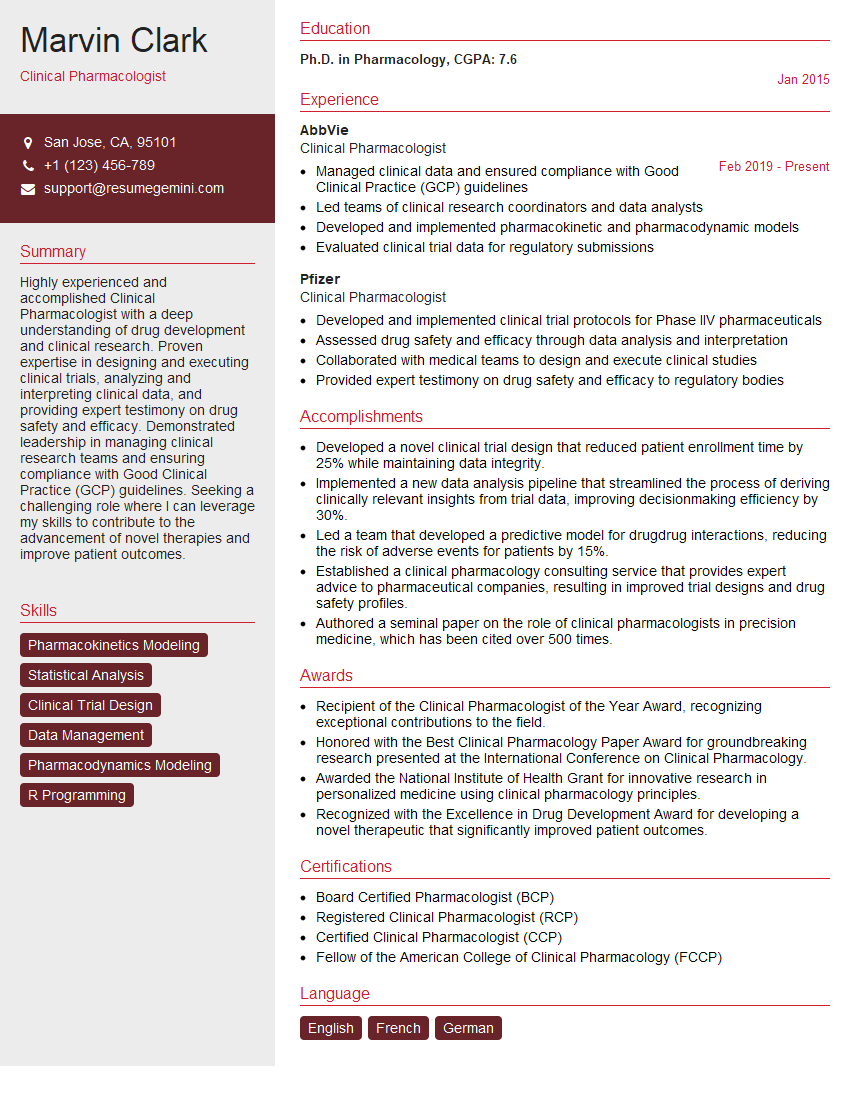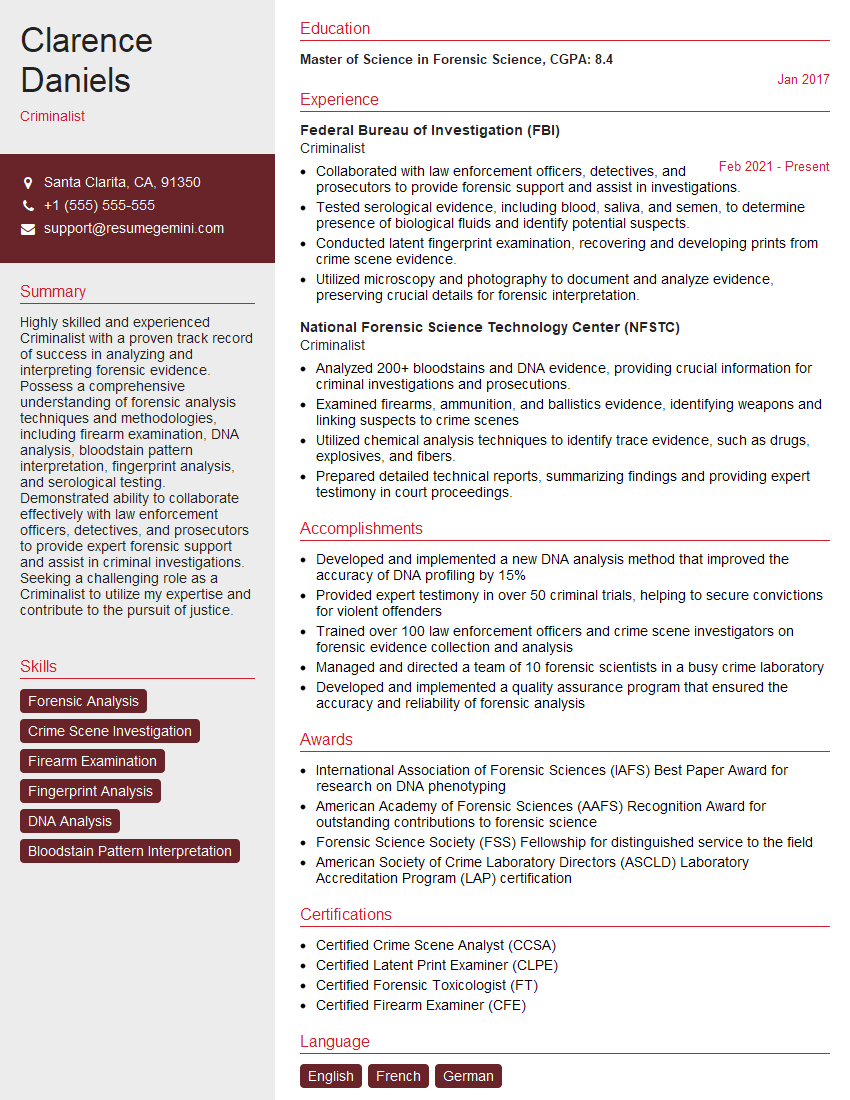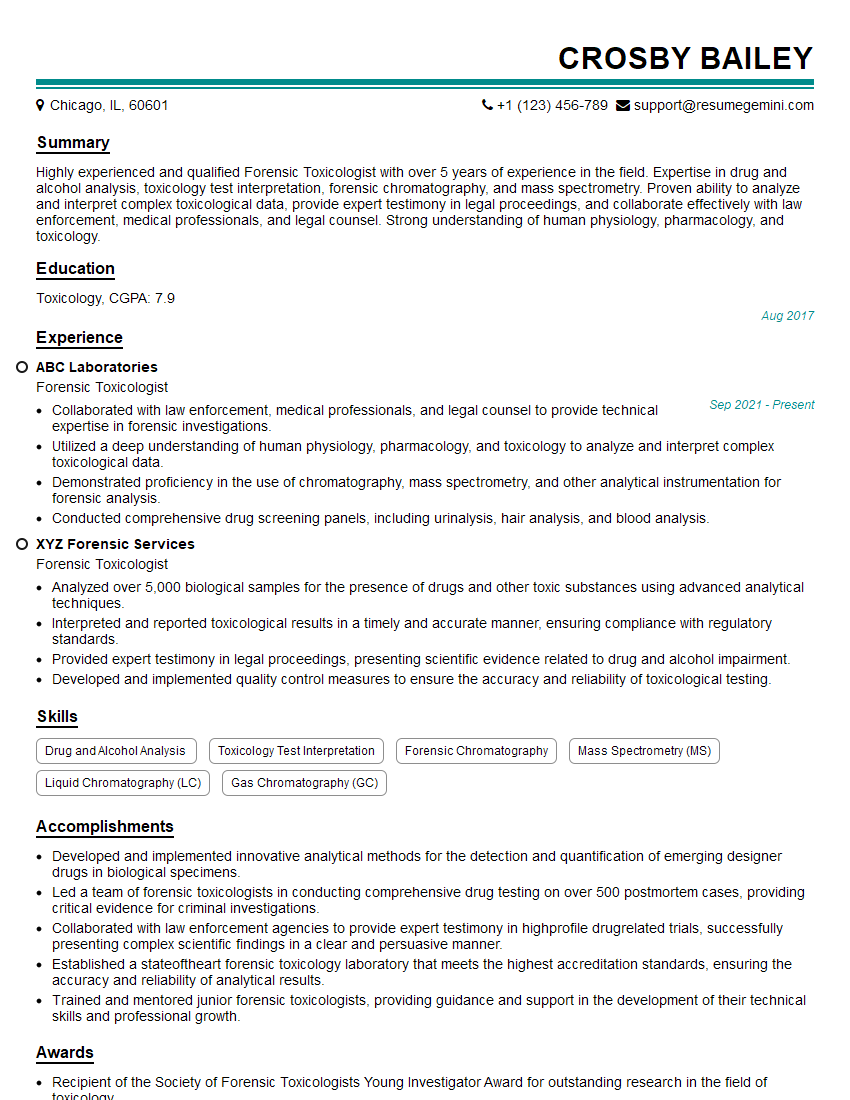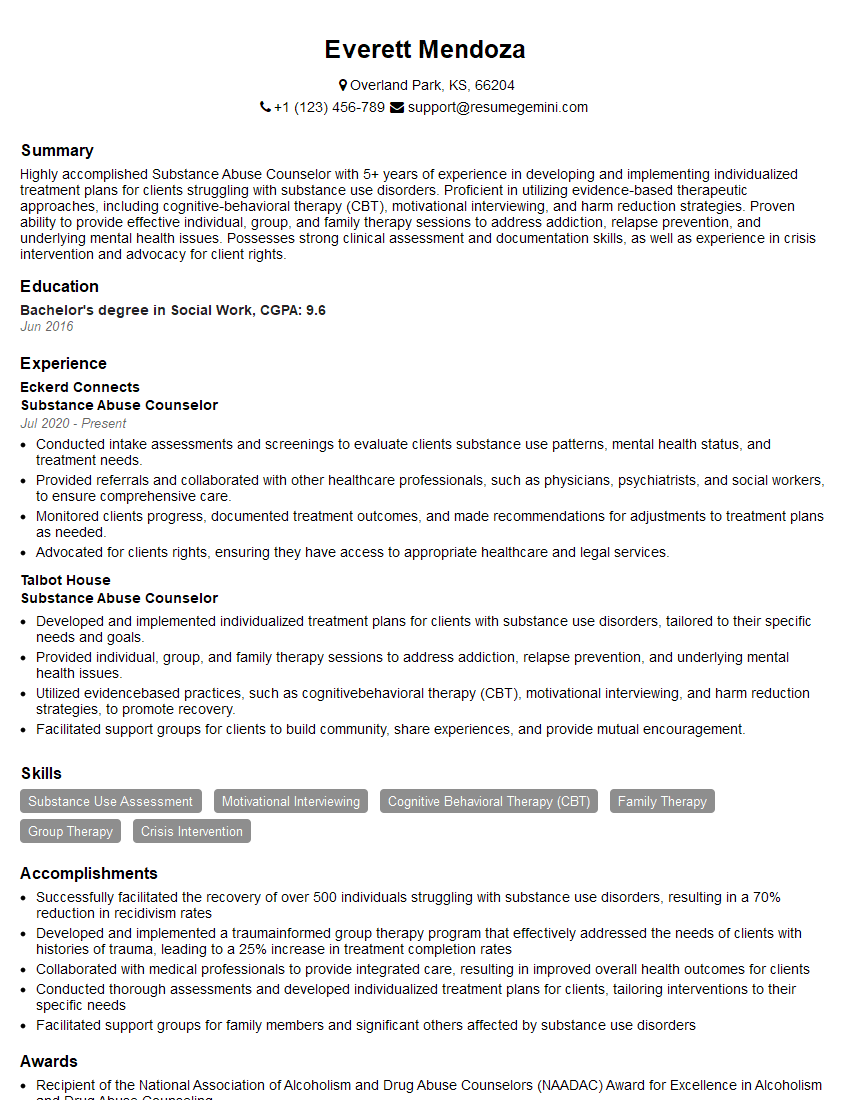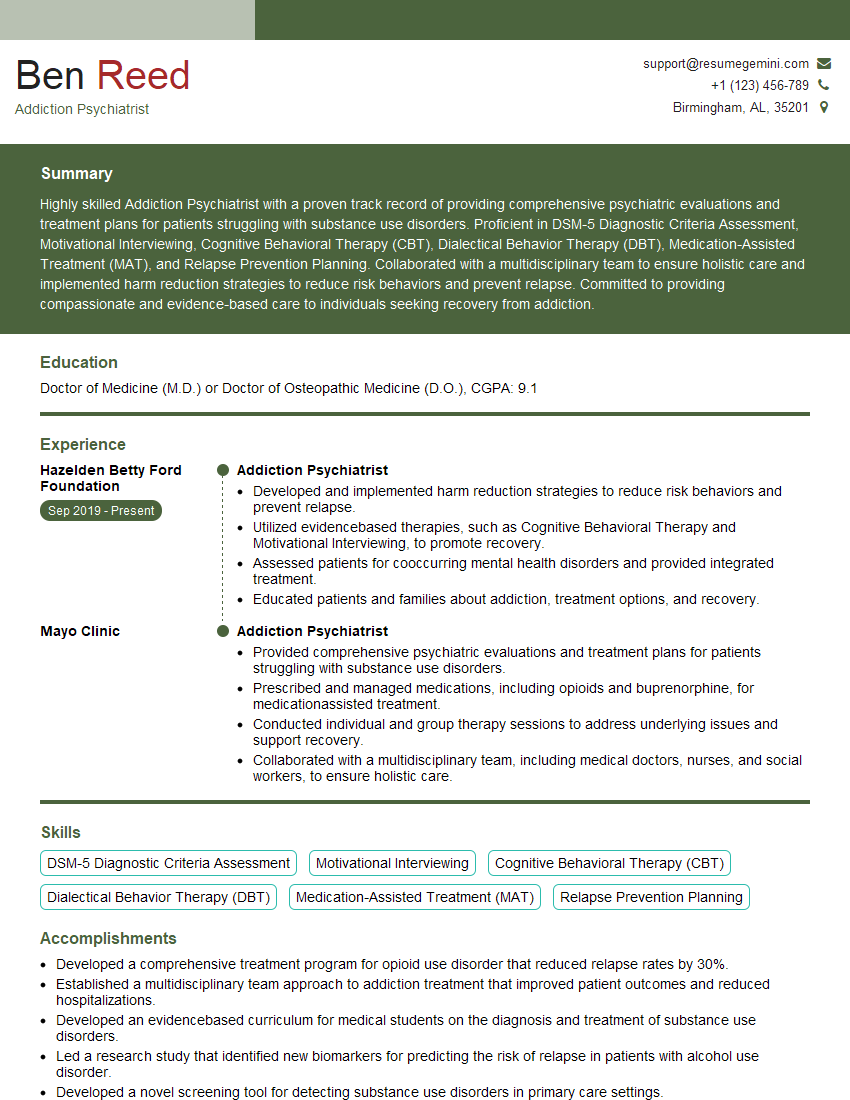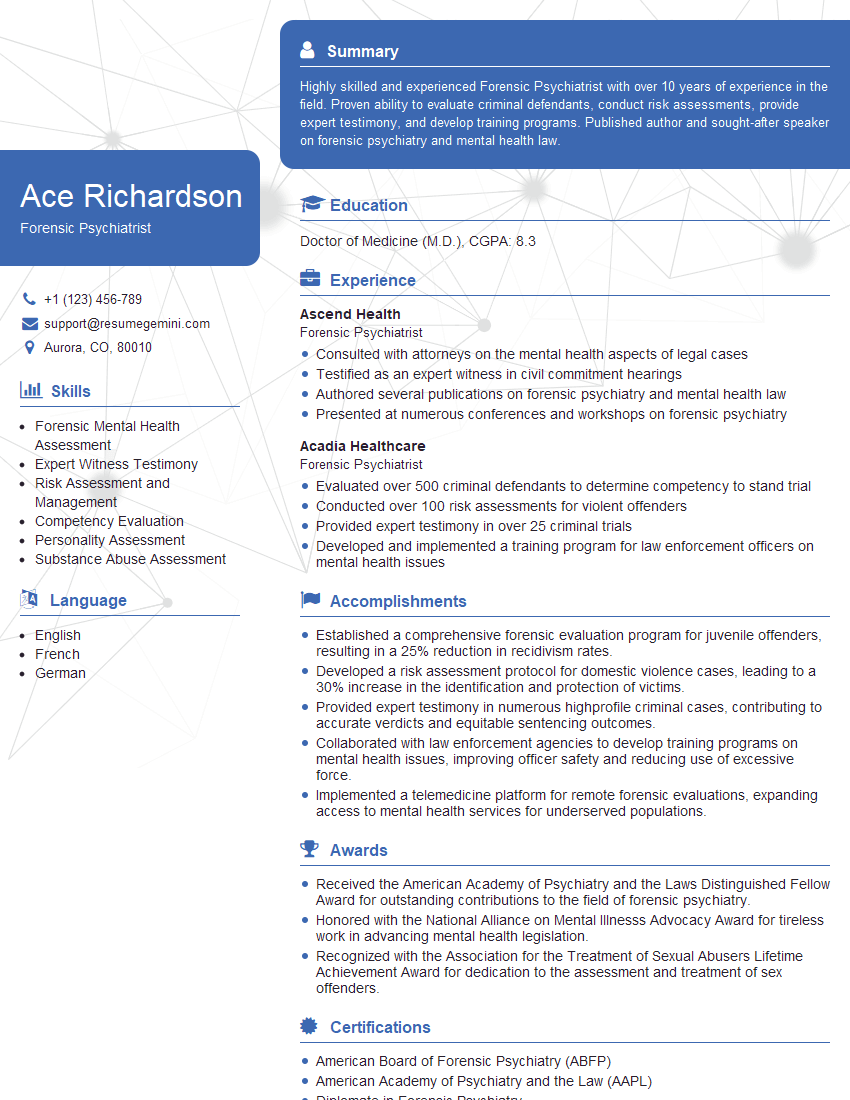The right preparation can turn an interview into an opportunity to showcase your expertise. This guide to Psychopharmacology and Forensic Drug Issues interview questions is your ultimate resource, providing key insights and tips to help you ace your responses and stand out as a top candidate.
Questions Asked in Psychopharmacology and Forensic Drug Issues Interview
Q 1. Describe the mechanism of action of benzodiazepines.
Benzodiazepines are a class of drugs that exert their effects by binding to specific receptors in the brain called GABAA receptors. These receptors are part of a larger system that regulates neuronal excitability. In simpler terms, imagine your brain’s neurons as a bustling city; GABA is like the traffic police officer that slows things down and keeps things calm. Benzodiazepines act as assistants to the GABA officer, making them even more effective at slowing down neuronal activity.
The mechanism is allosteric modulation. This means that benzodiazepines don’t directly activate the GABAA receptor, but they increase the receptor’s sensitivity to GABA. When GABA binds to the receptor, it opens a chloride ion channel, allowing chloride ions to flow into the neuron. This influx of negatively charged chloride ions hyperpolarizes the neuron, making it less likely to fire and reducing overall brain activity. This reduction in neuronal activity translates to the sedative, anxiolytic (anxiety-reducing), and muscle-relaxant effects we associate with benzodiazepines.
Different benzodiazepines have varying affinities for the GABAA receptor subtypes, leading to differences in their clinical effects and duration of action. For instance, some are fast-acting and short-lived, ideal for treating acute anxiety, while others are long-acting and better suited for chronic anxiety management.
Q 2. Explain the difference between tolerance and dependence in substance abuse.
Tolerance and dependence are distinct but related concepts in substance abuse. Tolerance refers to the need for increasingly larger doses of a drug to achieve the same effect. Think of it like building resistance; your body adapts to the presence of the drug, requiring more to get the initial impact. This is a physiological adaptation. Dependence, on the other hand, encompasses both physical and psychological components.
Physical dependence manifests as withdrawal symptoms when the drug is abruptly stopped. The body has become so accustomed to the drug’s presence that its absence causes a disruption in normal functioning, leading to various unpleasant symptoms. This is a consequence of the body’s attempt to regain its balance after prolonged drug exposure.
Psychological dependence refers to a compulsive craving for the drug, driven by psychological factors such as stress, anxiety, or the feeling of needing it to cope with everyday life. Even without physical withdrawal symptoms, a person can experience strong urges to use the drug.
A simple analogy is exercise: Tolerance would be like needing to lift heavier weights to feel the same muscle burn. Dependence is a combination of needing to exercise for both physical health (to avoid muscle atrophy, for example) and mental well-being (the feeling of accomplishment and reduction in stress).
Q 3. What are the common withdrawal symptoms associated with opioid cessation?
Opioid withdrawal is a challenging and potentially dangerous process characterized by a range of unpleasant symptoms. The severity and duration of withdrawal vary depending on factors such as the type of opioid, dose, duration of use, and individual factors. It’s important to note that medically supervised detoxification is crucial to manage these symptoms safely.
Common withdrawal symptoms include:
- Gastrointestinal distress: Nausea, vomiting, diarrhea, abdominal cramping
- Muscle aches and pains: Muscle spasms, bone pain, increased sensitivity to pain
- Central nervous system effects: Anxiety, irritability, restlessness, insomnia, increased sweating
- Autonomic nervous system effects: Increased heart rate, elevated blood pressure, dilated pupils
- Psychological symptoms: Depression, anxiety, intense drug craving
In severe cases, withdrawal can lead to life-threatening complications, highlighting the importance of medically-assisted treatment under the care of a qualified healthcare professional.
Q 4. Discuss the ethical considerations in prescribing controlled substances.
Prescribing controlled substances involves significant ethical considerations. The fundamental principle is the physician’s responsibility to act in the best interest of the patient while adhering to legal and professional guidelines. This requires careful balancing of several factors.
Key ethical considerations include:
- Beneficence and Non-maleficence: Weighing the potential benefits of the medication against the risks of addiction, side effects, and potential misuse. This necessitates a thorough assessment of the patient’s condition and a careful evaluation of alternative treatments.
- Autonomy: Respecting the patient’s right to make informed decisions about their treatment, ensuring they understand the risks and benefits, as well as alternative options.
- Justice: Fair and equitable distribution of controlled substances, avoiding bias and ensuring access for all patients who legitimately require them.
- Confidentiality: Maintaining patient confidentiality in accordance with legal and professional regulations. This includes safeguarding patient information and adhering to data privacy laws.
- Legal Compliance: Adhering to all relevant laws and regulations regarding the prescription and monitoring of controlled substances, including proper documentation and record-keeping.
A thorough patient history, risk assessment, and ongoing monitoring are crucial to mitigate the risks and ensure responsible prescribing practices.
Q 5. How do you interpret a toxicology report?
Interpreting a toxicology report requires careful consideration of several factors. It’s not simply about identifying the presence of a substance; it’s about understanding the context of the findings.
The interpretation process involves:
- Identifying the substances detected: The report will list the substances found and their concentrations.
- Considering the analytical method used: Different methods have varying sensitivities and specificities, impacting the accuracy and reliability of the results.
- Evaluating the concentrations of the substances: The concentration of a substance can indicate the extent of exposure or recent use. However, concentration alone doesn’t always determine the clinical significance.
- Understanding the context of the sample: The type of sample (e.g., blood, urine, hair) impacts the interpretation. For instance, hair samples provide a longer-term exposure picture than urine.
- Considering the patient’s medical history: The patient’s history of drug use, medications, and underlying medical conditions is crucial to properly interpreting the results.
- Correlation with other clinical information: The toxicology report should be interpreted in conjunction with other clinical data, such as symptoms, vital signs, and medical history, to form a complete clinical picture.
It’s important to note that a toxicology report is just one piece of the puzzle in assessing a patient’s condition. A qualified medical professional must interpret the results within the broader clinical context.
Q 6. What are the limitations of drug screening tests?
Drug screening tests, while useful tools, have limitations that need to be acknowledged.
These limitations include:
- False positives: A test may incorrectly indicate the presence of a drug when it’s not actually there. This can be due to cross-reactivity with other substances or interference from other compounds in the sample.
- False negatives: A test may fail to detect a drug even when it’s present. This can be due to low concentrations of the drug, the use of a less sensitive test, or the drug’s metabolism.
- Limited detection window: The time frame during which a drug can be detected varies depending on the drug, the testing method, and the matrix (e.g., urine, blood). Some drugs are eliminated quickly, leading to a narrow detection window.
- Lack of quantification: Many screening tests only indicate the presence or absence of a drug, not the specific concentration. This lack of quantitative data can limit the clinical interpretation.
- Potential for drug adulteration: Individuals may attempt to manipulate test results by adulterating the sample or using masking agents.
Therefore, the results of drug screening tests should be interpreted cautiously and in conjunction with other clinical information. Confirmatory testing using more specific methods may be necessary to confirm positive results.
Q 7. Explain the pharmacokinetics of cocaine.
Cocaine’s pharmacokinetics, the study of its absorption, distribution, metabolism, and excretion, is complex and influences its rapid and intense effects.
Absorption: Cocaine is rapidly absorbed after intranasal, intravenous, or smoking routes of administration. Intravenous administration leads to the most rapid onset of effects. After intranasal use, absorption is slower due to the need to cross mucosal membranes. Smoking results in nearly immediate absorption into the bloodstream.
Distribution: Once absorbed, cocaine is widely distributed throughout the body, readily crossing the blood-brain barrier. Its high lipid solubility allows for rapid penetration into the central nervous system, explaining the swift onset of its psychoactive effects.
Metabolism: Cocaine is primarily metabolized in the liver, primarily by hydrolysis to benzoylecgonine, a major metabolite detected in urine drug testing. Other metabolites include ecgonine methyl ester and norcocaine. The half-life of cocaine is relatively short, typically ranging from 30 to 90 minutes, although the metabolites can be detected in the urine for days.
Excretion: Cocaine and its metabolites are primarily excreted in the urine, although some excretion also occurs through sweat and feces. The detection window in urine varies depending on the frequency of use and factors such as individual metabolism and renal function.
Understanding cocaine’s pharmacokinetics is vital for clinicians to interpret clinical findings, manage overdoses, and develop appropriate treatment strategies.
Q 8. Describe the pharmacodynamics of amphetamines.
Amphetamines exert their effects primarily by increasing the release and blocking the reuptake of dopamine, norepinephrine, and serotonin in the brain. This leads to a surge of these neurotransmitters in the synaptic cleft, resulting in the characteristic stimulant effects.
Pharmacodynamics Explained: Think of a synapse as a tiny gap between nerve cells. Neurotransmitters are the chemical messengers that cross this gap. Amphetamines act like a traffic controller gone wild: they force the release of more neurotransmitters than usual (increased release), and they prevent the neurotransmitters from being cleared from the synapse (blocked reuptake). This means there’s a much higher concentration of these stimulating chemicals, resulting in increased alertness, energy, and mood elevation. The duration and intensity of these effects depend on factors like the specific amphetamine (e.g., methamphetamine vs. dextroamphetamine), the dose, and individual factors like metabolism.
Examples of effects: Increased heart rate and blood pressure, heightened alertness and focus (initially), increased energy, euphoria, appetite suppression, and decreased fatigue are all pharmacodynamic effects. However, these effects are followed by a crash – a period of fatigue, depression, and irritability, as the brain struggles to return to its normal neurotransmitter balance.
Q 9. What are the different types of drug interactions?
Drug interactions occur when the effect of one drug is altered by the presence of another drug. These interactions can be categorized in several ways.
- Pharmacokinetic Interactions: These affect the absorption, distribution, metabolism, or excretion (ADME) of a drug. For example, a drug might inhibit an enzyme responsible for metabolizing another drug, leading to increased levels of the second drug in the blood and potentially toxicity. This is called enzyme inhibition.
- Pharmacodynamic Interactions: These occur when two drugs affect the same physiological system or target the same receptor, either additively (1+1=2), synergistically (1+1>2), or antagonistically (1+1<1). For example, two sedatives taken together could cause excessive sedation, while a stimulant and a sedative might counteract each other's effects.
- Drug-Food Interactions: Certain foods can alter the absorption or metabolism of some drugs. For example, grapefruit juice inhibits certain enzymes involved in drug metabolism, leading to increased drug levels.
- Drug-Disease Interactions: A patient’s underlying health condition can influence how a drug is processed or its effectiveness. For example, kidney or liver disease can impair drug metabolism and excretion, leading to drug accumulation.
Understanding drug interactions is critical for safe and effective prescribing, highlighting the need for a thorough patient medication history.
Q 10. How do you manage a patient experiencing an acute overdose?
Managing an acute overdose requires a rapid, coordinated response focused on stabilizing vital functions and minimizing toxicity. The specific management will depend on the drug involved, but general principles include:
- Secure the airway and ensure adequate ventilation and oxygenation. This is always the priority in any overdose situation.
- Administer activated charcoal. Activated charcoal can absorb the drug in the gastrointestinal tract, reducing absorption. It is most effective within a few hours of ingestion.
- Provide supportive care: Monitor vital signs (heart rate, blood pressure, respiration, temperature), manage seizures if they occur, and provide intravenous fluids if necessary.
- Consider specific antidotes: For some drug overdoses, there are specific antidotes. For example, naloxone is a specific antidote for opioid overdoses.
- Gastric lavage (stomach pumping) is generally not recommended, except in specific circumstances. It is rarely effective and carries a risk of complications.
- Continuous monitoring is essential: Patients need to be observed closely for changes in their condition.
In all overdose scenarios, immediate medical attention is crucial. Time is of the essence. Call emergency services (911 or equivalent) immediately.
Q 11. Discuss the role of genetics in drug response.
Genetics play a significant role in how individuals respond to drugs. Genetic variations can affect drug metabolism, transport, and receptor binding. This leads to differences in drug efficacy and the risk of adverse effects.
Examples:
- CYP450 Enzymes: Many drugs are metabolized by cytochrome P450 (CYP450) enzymes. Genetic variations in CYP450 genes can lead to either faster or slower metabolism of certain drugs, affecting drug levels in the body. Individuals with slower metabolism might experience higher drug concentrations and increased risk of side effects, whereas those with faster metabolism might require higher doses to achieve the desired therapeutic effect.
- Drug Transporters: Genetic variations can also affect drug transporters, proteins responsible for moving drugs into and out of cells. These variations could influence drug absorption, distribution, and elimination.
- Drug Receptors: Genetic variations in drug receptors can affect drug binding and the intensity of the drug’s response. Some individuals might have more or less sensitive receptors leading to increased or decreased therapeutic effect or increased side effects.
Pharmacogenomics, the study of how genes affect drug response, is becoming increasingly important for personalizing drug therapy and minimizing adverse effects. Genetic testing can potentially help predict an individual’s response to a specific drug, enabling doctors to make more informed decisions regarding treatment plans.
Q 12. Explain the concept of therapeutic drug monitoring.
Therapeutic drug monitoring (TDM) involves measuring the concentration of a drug in a patient’s blood or other bodily fluids to optimize drug therapy. It is particularly useful for drugs with a narrow therapeutic index (the difference between the effective dose and the toxic dose is small), where maintaining a specific concentration is crucial to ensure efficacy and safety.
Purpose of TDM:
- Guide dosing: To individualize the dose to achieve a therapeutic concentration and minimize adverse events.
- Assess compliance: TDM can help determine if the patient is taking the medication as prescribed.
- Detect drug interactions: Changes in drug levels may indicate drug interactions.
- Monitor toxicity: TDM can be used to monitor the levels of toxic drugs.
Examples of drugs commonly monitored: Many drugs, including some immunosuppressants, anticonvulsants, aminoglycoside antibiotics, and antidepressants, can benefit from TDM. The specific drugs monitored and the frequency of monitoring depend on several factors, including the patient’s clinical condition, drug pharmacokinetics, and therapeutic goals.
Q 13. What are the legal ramifications of substance abuse in the workplace?
Substance abuse in the workplace carries significant legal ramifications, varying depending on the jurisdiction and the specifics of the situation. The consequences can impact both the employee and the employer.
For the Employee:
- Disciplinary action: Employers can impose disciplinary actions ranging from warnings and mandatory drug treatment to suspension or termination.
- Legal prosecution: Depending on the nature and severity of the substance abuse (e.g., driving under the influence), employees can face criminal charges.
- Civil lawsuits: If the substance abuse leads to accidents or injuries, the employee could be held liable in civil lawsuits.
For the Employer:
- Legal liability: Employers can face legal repercussions if they fail to address employee substance abuse, especially if it leads to workplace accidents or injuries.
- OSHA regulations: Occupational Safety and Health Administration (OSHA) regulations require employers to maintain a safe workplace. Ignoring substance abuse can violate these regulations.
- Insurance implications: Workplace accidents caused by substance abuse can significantly impact insurance premiums.
Employers usually have policies in place regarding substance abuse, often including drug testing, counseling programs, and employee assistance programs (EAPs). The legal aspects are complex and often require legal counsel.
Q 14. Describe the various methods used in forensic drug analysis.
Forensic drug analysis employs a variety of techniques to identify and quantify drugs and other substances in biological samples (blood, urine, hair), or other materials (e.g., seized drugs). These methods must adhere to strict chain of custody protocols to maintain evidentiary integrity.
Common methods include:
- Immunoassay: Relatively rapid and inexpensive screening tests, such as enzyme-linked immunosorbent assays (ELISAs), often used initially to screen for the presence of specific drugs. They’re less specific than other methods and require confirmation.
- Gas Chromatography-Mass Spectrometry (GC-MS): A highly sensitive and specific technique that separates drug components and identifies them based on their mass-to-charge ratio. It’s commonly used for confirming drug presence and identifying specific drug metabolites.
- Liquid Chromatography-Mass Spectrometry (LC-MS): Similar to GC-MS but better suited for analyzing non-volatile or thermally labile compounds. This is often used for analyzing a wider array of drugs, including those found in more complex matrices.
- Spectroscopy (UV-Vis, IR, NMR): Techniques that examine the interaction of light with the substance, providing information about its chemical structure.
- Thin-Layer Chromatography (TLC): A simple and inexpensive technique used for preliminary separation and identification of drug mixtures.
The choice of method depends on the type of sample, the target analytes, the sensitivity required, and the resources available. Forensic toxicology laboratories use a combination of these techniques to ensure accurate and reliable results, often starting with a screening test followed by confirmation using a more definitive method like GC-MS or LC-MS.
Q 15. Discuss the challenges in treating substance use disorders.
Treating substance use disorders (SUDs) presents a multitude of challenges, stemming from the complex interplay of biological, psychological, and social factors. One major hurdle is the high rate of relapse. Addiction alters brain chemistry, creating powerful cravings that can persist even after extended periods of abstinence. This makes sustained recovery a difficult, often lifelong process requiring ongoing support and vigilance.
Another challenge lies in patient motivation and engagement. Individuals with SUDs may struggle with denial, lack of insight into their condition, or resistance to treatment. Building trust and fostering a collaborative therapeutic alliance is crucial but can be time-consuming and challenging, especially in cases involving comorbid mental health disorders.
Further complicating treatment is the heterogeneity of SUDs. Each substance has unique effects on the brain and body, necessitating tailored treatment strategies. Furthermore, individuals respond differently to various treatments, requiring careful monitoring and adjustments to optimize outcomes. Access to quality care, including medication-assisted treatment (MAT) and psychosocial interventions, remains a significant barrier for many, particularly those in underserved communities.
Finally, the social stigma associated with addiction can deter individuals from seeking help. Fear of judgment, discrimination, and loss of employment or social connections can prevent individuals from acknowledging their problem and engaging in treatment. Addressing this stigma through education and increased public awareness is essential for improving treatment outcomes.
Career Expert Tips:
- Ace those interviews! Prepare effectively by reviewing the Top 50 Most Common Interview Questions on ResumeGemini.
- Navigate your job search with confidence! Explore a wide range of Career Tips on ResumeGemini. Learn about common challenges and recommendations to overcome them.
- Craft the perfect resume! Master the Art of Resume Writing with ResumeGemini’s guide. Showcase your unique qualifications and achievements effectively.
- Don’t miss out on holiday savings! Build your dream resume with ResumeGemini’s ATS optimized templates.
Q 16. What are the common side effects of antidepressant medications?
Antidepressant medications, while highly effective for many, can produce a range of side effects, some mild and transient, others more severe and requiring attention. Common side effects vary depending on the specific medication but frequently include:
- Gastrointestinal issues: Nausea, vomiting, diarrhea, constipation
- Sexual dysfunction: Decreased libido, erectile dysfunction, anorgasmia
- Weight changes: Weight gain or loss
- Sedation or insomnia: Difficulty sleeping or excessive daytime sleepiness
- Headaches: Frequent or persistent headaches
- Dizziness or lightheadedness: Feeling unsteady or faint
- Dry mouth: Reduced saliva production
In rarer instances, more serious side effects can occur, including serotonin syndrome (a potentially life-threatening condition characterized by agitation, confusion, muscle rigidity, and fever), mania (in individuals with bipolar disorder), and increased suicidal ideation, particularly in young adults. Careful monitoring and prompt attention to any concerning side effects are vital for ensuring patient safety and treatment efficacy.
Q 17. Explain the difference between different classes of antidepressants (SSRIs, SNRIs, etc.)
Different classes of antidepressants work primarily by affecting the availability of specific neurotransmitters in the brain, primarily serotonin, norepinephrine, and dopamine. The key differences lie in their mechanism of action:
- SSRIs (Selective Serotonin Reuptake Inhibitors): Primarily increase serotonin levels by blocking its reuptake into presynaptic neurons. Examples include fluoxetine (Prozac), sertraline (Zoloft), and paroxetine (Paxil).
- SNRIs (Serotonin-Norepinephrine Reuptake Inhibitors): Increase both serotonin and norepinephrine levels by inhibiting their reuptake. Examples include venlafaxine (Effexor) and duloxetine (Cymbalta).
- TCAs (Tricyclic Antidepressants): Block the reuptake of both serotonin and norepinephrine, as well as having some effects on other receptors. They are generally considered second-line treatments due to their higher side effect profile. Examples include amitriptyline and imipramine.
- MAOIs (Monoamine Oxidase Inhibitors): Inhibit the enzyme monoamine oxidase, which breaks down neurotransmitters like serotonin, norepinephrine, and dopamine. These are typically reserved for cases that haven’t responded to other treatments due to potential interactions with certain foods and medications.
- NDRIs (Norepinephrine-Dopamine Reuptake Inhibitors): Primarily increase norepinephrine and dopamine levels. Bupropion (Wellbutrin) is a prominent example.
The choice of antidepressant depends on several factors including the individual’s specific symptoms, medical history, potential side effects, and response to previous treatments. This decision should be made in consultation with a psychiatrist or other qualified healthcare professional.
Q 18. How do you assess a patient’s risk for substance abuse?
Assessing a patient’s risk for substance abuse involves a comprehensive approach that integrates several key elements. This involves taking a detailed history including a thorough substance use history, family history of substance abuse, and past or current mental health issues. Clinical interviews should assess patterns of use, methods of administration, and the presence of any withdrawal symptoms. Using standardized screening tools such as the AUDIT-C (Alcohol Use Disorders Identification Test-Consumption) or DAST (Drug Abuse Screening Test) can be helpful in quantifying risk.
Behavioral observations during the interview are crucial. Note any signs of intoxication or withdrawal. Collateral information from family members, friends, or other healthcare providers is often valuable, particularly if the patient is not fully forthcoming. In addition to the clinical assessment, laboratory tests, such as toxicology screenings or blood tests can provide objective data. Overall, risk assessment requires a multifaceted approach that combines subjective and objective measures to paint a comprehensive picture of the patient’s risk profile. This then allows for a tailored treatment plan aimed at mitigating risks and promoting recovery.
Q 19. What are the principles of harm reduction in addiction treatment?
Harm reduction is a set of pragmatic strategies aimed at minimizing the negative consequences associated with substance use, rather than focusing solely on complete abstinence. This approach recognizes that complete abstinence isn’t always achievable or realistic for every individual, especially in the early stages of treatment. The principles underpinning harm reduction include:
- Meeting people where they are: Accepting individuals at their current stage of readiness for change, rather than imposing abstinence as an immediate goal.
- Focusing on reducing harm: Prioritizing strategies to minimize negative consequences of substance use, such as providing access to sterile injection equipment for people who inject drugs or educating about safe drug use practices.
- Non-judgmental approach: Creating a supportive and non-judgmental environment to encourage engagement with services.
- Empowerment and self-determination: Respecting individuals’ autonomy and supporting their choices within the framework of harm reduction strategies.
- Collaboration and partnership: Working collaboratively with individuals, their families, and communities to develop effective harm reduction strategies tailored to their specific needs.
Examples of harm reduction strategies include supervised consumption sites, naloxone distribution programs, needle exchange programs, and medication-assisted treatment.
Q 20. Explain the role of neurotransmitters in addiction.
Neurotransmitters play a crucial role in the development and maintenance of addiction. These chemical messengers transmit signals between nerve cells in the brain, influencing mood, motivation, reward, and pleasure. Addiction disrupts the normal functioning of these neurotransmitter systems. The reward pathway, involving dopamine, is central to this process. Substances of abuse activate this pathway, leading to a surge of dopamine, which reinforces the behavior and creates a strong association between the substance and feelings of pleasure and reward. With repeated use, the brain adapts to the chronic influx of dopamine, leading to a decrease in natural dopamine production and an increased tolerance to the drug’s effects. This makes it difficult for the person to experience pleasure from anything but the substance.
Other neurotransmitters implicated in addiction include: glutamate (involved in learning and memory, strengthening the associations between drug use and cues), GABA (which regulates anxiety and stress, playing a role in withdrawal symptoms), and endogenous opioids (which contribute to feelings of euphoria and pain relief). The complex interaction of these neurotransmitter systems explains why addiction is such a challenging condition to overcome.
Q 21. Discuss the impact of chronic substance use on the brain.
Chronic substance use has profound and long-lasting effects on the brain. These changes occur at multiple levels, including alterations in brain structure, function, and neurochemistry. The prefrontal cortex, responsible for executive functions such as decision-making, planning, and impulse control, is particularly vulnerable. Chronic drug use can lead to atrophy (shrinkage) of this brain region, impairing judgment and increasing impulsivity, contributing to continued substance abuse. Other areas affected include the hippocampus (important for memory and learning), which can lead to memory problems and difficulty forming new memories, and the amygdala (involved in processing emotions), which can contribute to emotional dysregulation and increased anxiety or irritability.
Furthermore, chronic substance use can disrupt the balance of neurotransmitters, leading to changes in mood, motivation, and reward processing. These neurochemical imbalances can persist even after cessation of drug use, contributing to relapse and difficulty maintaining abstinence. The severity of these changes depends on factors such as the type of substance used, the duration and intensity of use, and the individual’s genetic predisposition. Understanding these neurobiological changes is essential for developing effective treatments and interventions aimed at mitigating the long-term effects of substance use on the brain.
Q 22. What are the evidence-based treatments for opioid addiction?
Evidence-based treatments for opioid addiction are multifaceted and usually involve a combination of approaches tailored to the individual’s needs. The cornerstone is Medication-Assisted Treatment (MAT), which uses medications to reduce cravings and withdrawal symptoms, making it easier to engage in therapy and maintain abstinence.
- Methadone: A full opioid agonist, it stabilizes the opioid system, reducing cravings and withdrawal symptoms.
- Buprenorphine: A partial opioid agonist, it offers similar benefits to methadone with a lower risk of overdose.
- Naltrexone: An opioid antagonist, it blocks the effects of opioids, helping prevent relapse but requires a period of detoxification first.
Beyond MAT, behavioral therapies play a vital role. These include:
- Cognitive Behavioral Therapy (CBT): Helps individuals identify triggers, develop coping mechanisms, and challenge negative thought patterns that contribute to relapse.
- Contingency Management (CM): Uses rewards and incentives to reinforce abstinence and adherence to treatment.
- Counseling (individual and group): Provides support, education, and a safe space for individuals to process their experiences and build a support system.
The most effective treatment combines MAT with behavioral therapies, offering a comprehensive approach to managing the physical and psychological aspects of opioid addiction. For instance, a patient might receive buprenorphine for withdrawal management, coupled with CBT to address underlying issues driving their opioid use.
Q 23. Explain the role of motivational interviewing in addiction treatment.
Motivational Interviewing (MI) is a patient-centered, directive counseling style designed to elicit and strengthen motivation for change. It’s particularly effective in addiction treatment because it avoids confrontation and empowers the individual to take ownership of their recovery. Instead of imposing solutions, MI helps individuals explore their ambivalence toward change, identifying their own reasons for wanting to change and overcoming their reservations.
The core principles of MI are:
- Expressing empathy: Understanding the individual’s perspective without judgment.
- Developing discrepancy: Helping the individual see the discrepancies between their goals and their current behaviors.
- Rolling with resistance: Avoiding direct confrontation and instead exploring the reasons for resistance.
- Supporting self-efficacy: Emphasizing the individual’s capacity for change and fostering belief in their ability to succeed.
In practice, an MI therapist might ask open-ended questions like, “What are some things you like about using drugs?” and “What are some things you don’t like?” This helps the individual articulate their ambivalence and gradually move towards a decision for change. MI is often used in conjunction with other therapies to enhance engagement and treatment adherence. For example, it can be used to prepare a patient for CBT or medication initiation.
Q 24. Describe different treatment modalities for substance use disorders.
Treatment modalities for substance use disorders are diverse and depend on the specific substance, the severity of the disorder, and the individual’s needs. Common approaches include:
- Detoxification: Medically supervised withdrawal from the substance to manage withdrawal symptoms safely.
- Inpatient treatment: Residential treatment programs providing 24/7 care in a structured environment.
- Outpatient treatment: Less intensive treatment, allowing individuals to continue living at home while attending regular sessions.
- Medication-assisted treatment (MAT): As discussed earlier, uses medications to manage withdrawal symptoms and cravings (e.g., methadone for opioid addiction, naltrexone for alcohol addiction).
- Behavioral therapies: Including CBT, MI, and contingency management, these therapies target underlying psychological factors contributing to substance use.
- Support groups: Such as Alcoholics Anonymous (AA) or Narcotics Anonymous (NA), these groups offer peer support and a sense of community.
- Family therapy: Involving family members in the treatment process to address family dynamics that may contribute to the individual’s substance use.
A comprehensive approach typically integrates several modalities. For example, an individual with opioid addiction might undergo medically supervised detoxification, followed by MAT with buprenorphine, CBT, and attendance at support group meetings.
Q 25. How do you differentiate between substance abuse and substance dependence?
The distinction between substance abuse and substance dependence (now often referred to as substance use disorder in the DSM-5) lies in the severity and impact of the substance use on the individual’s life. While both involve problematic substance use, dependence signifies a more severe condition characterized by significant impairment and loss of control.
Substance abuse (under the older DSM-IV criteria) involved harmful consequences from substance use, such as legal problems, relationship difficulties, or neglecting responsibilities. However, it didn’t necessarily imply physiological dependence (tolerance or withdrawal).
Substance dependence (DSM-IV) or Substance Use Disorder (DSM-5) involves a combination of tolerance, withdrawal, compulsive drug seeking, and a significant impact on various life domains. This could include:
- Tolerance: Needing more of the substance to achieve the same effect.
- Withdrawal: Experiencing physical or psychological symptoms when the substance is stopped or reduced.
- Loss of control: Inability to limit substance use despite negative consequences.
- Neglecting responsibilities: Prioritizing substance use over work, family, or other responsibilities.
- Continued use despite negative consequences: Persisting with substance use despite experiencing harm.
The DSM-5 uses a dimensional approach, classifying substance use disorders based on severity (mild, moderate, severe) based on the number of criteria met.
Q 26. What are some common challenges encountered in forensic drug investigations?
Forensic drug investigations present numerous challenges, including:
- Sample contamination or degradation: Samples can be contaminated during collection, storage, or transport, leading to inaccurate results. Degradation can also occur over time, affecting the concentration of the substances present.
- Adulterants and cutting agents: Illicit drugs are often mixed with other substances, making identification and quantification challenging. The presence of cutting agents can significantly alter the drug’s potency and potentially toxicity.
- Lack of sufficient sample: Obtaining a sufficient sample size for analysis can be difficult, especially in cases involving trace amounts of drugs.
- Complex mixtures: Samples often contain multiple substances, necessitating sophisticated analytical techniques to separate and identify each component.
- Interpretation of results: Interpreting analytical results within a forensic context requires expertise in toxicology, pharmacology, and legal issues.
- Chain of custody issues: Maintaining proper chain of custody to ensure the integrity of the evidence is crucial but can be complex to manage in the field.
For example, a blood sample from a suspected drug-impaired driver might be contaminated by environmental substances during collection. Or, a seized drug sample may contain various cutting agents, making accurate identification of the main drug challenging.
Q 27. How would you approach a case involving the analysis of an unknown substance?
Analyzing an unknown substance requires a systematic approach involving several steps:
- Initial observation and presumptive testing: Observe the substance’s physical characteristics (color, odor, texture) and perform presumptive tests (color tests, immunoassays) to get an initial indication of its identity. These tests are not definitive but can provide clues.
- Instrumental analysis: Utilize more sophisticated analytical techniques such as gas chromatography-mass spectrometry (GC-MS) or liquid chromatography-mass spectrometry (LC-MS) to obtain a definitive identification and quantification of the substance and its components.
- Confirmation of identity: Compare the results obtained from instrumental analysis with known reference standards to confirm the identity of the substance.
- Quantification: Determine the concentration of the substance in the sample. This is essential for cases involving drug-impaired driving or other scenarios where the amount of the substance is relevant.
- Interpretation of results: Consider the context of the case, including the circumstances under which the substance was found, to interpret the analytical findings.
For instance, an unknown powder might initially appear white and crystalline. Presumptive tests could suggest the presence of cocaine. GC-MS analysis would then provide a definitive confirmation and quantify the cocaine concentration in the sample. The entire process must be meticulously documented to maintain the chain of custody and ensure the admissibility of evidence.
Q 28. What are the ethical considerations involved in conducting forensic drug analysis?
Ethical considerations in forensic drug analysis are paramount to maintaining the integrity of the justice system and protecting individual rights. Key ethical considerations include:
- Maintaining objectivity and impartiality: Analysts must remain impartial and avoid bias in their analysis and interpretation of results. This means following established protocols and avoiding any influence from external pressures.
- Ensuring the accuracy and reliability of results: Analysts have a responsibility to use appropriate methods, calibrate instruments regularly, and thoroughly document their work to ensure the accuracy and reliability of their findings.
- Protecting the confidentiality of client information: Forensic analysts often handle sensitive information, and maintaining client confidentiality is crucial. Sharing results only with authorized individuals or agencies is critical.
- Adhering to professional standards and regulations: Analysts must comply with all relevant professional standards, legal requirements, and regulations governing forensic analysis. This includes following established chain-of-custody procedures.
- Avoiding conflicts of interest: Analysts should avoid any situations that might create a conflict of interest, such as having a personal relationship with someone involved in the case.
- Maintaining professional competence: Analysts should engage in continuing education and training to stay updated on the latest techniques and technologies to uphold a high standard of professionalism.
A failure to maintain these ethical considerations can lead to wrongful convictions, compromised evidence, and erosion of public trust in the justice system.
Key Topics to Learn for Psychopharmacology and Forensic Drug Issues Interview
- Pharmacokinetics and Pharmacodynamics: Understanding drug absorption, distribution, metabolism, and excretion; relating these processes to drug effects and toxicity.
- Neuropharmacology: Exploring the mechanisms of action of psychotropic medications on neurotransmitter systems (e.g., dopamine, serotonin, GABA).
- Drug Classes in Psychopharmacology: In-depth knowledge of antidepressants, antipsychotics, anxiolytics, mood stabilizers, and stimulants, including their therapeutic uses, side effects, and potential interactions.
- Substance Use Disorders: Understanding the diagnostic criteria, etiology, and treatment approaches for various substance use disorders (e.g., opioid addiction, alcohol dependence).
- Forensic Toxicology: Familiarizing yourself with analytical techniques used in drug detection and analysis, interpretation of toxicology reports, and the legal implications of drug findings.
- Legal Aspects of Drug Use: Understanding relevant legislation, regulations, and legal frameworks surrounding drug possession, trafficking, and prescription practices.
- Ethical Considerations: Exploring ethical dilemmas related to patient confidentiality, informed consent, and the responsible prescribing of psychotropic medications.
- Case Studies and Problem-Solving: Practicing applying your knowledge to real-world scenarios involving drug identification, treatment planning, and legal implications.
- Research Methods in Psychopharmacology: Understanding the design and interpretation of clinical trials, epidemiological studies, and other research methodologies relevant to the field.
Next Steps
Mastering Psychopharmacology and Forensic Drug Issues is crucial for career advancement in fields like clinical psychology, psychiatry, forensic science, and pharmaceutical research. A strong understanding of these concepts will significantly enhance your interview performance and overall professional credibility. To increase your job prospects, create an ATS-friendly resume that effectively highlights your skills and experience. ResumeGemini is a trusted resource to help you build a professional and impactful resume. They provide examples of resumes tailored to Psychopharmacology and Forensic Drug Issues, ensuring your application stands out from the competition. Take the next step towards your dream career by crafting a compelling resume today.
Explore more articles
Users Rating of Our Blogs
Share Your Experience
We value your feedback! Please rate our content and share your thoughts (optional).
What Readers Say About Our Blog
This was kind of a unique content I found around the specialized skills. Very helpful questions and good detailed answers.
Very Helpful blog, thank you Interviewgemini team.
